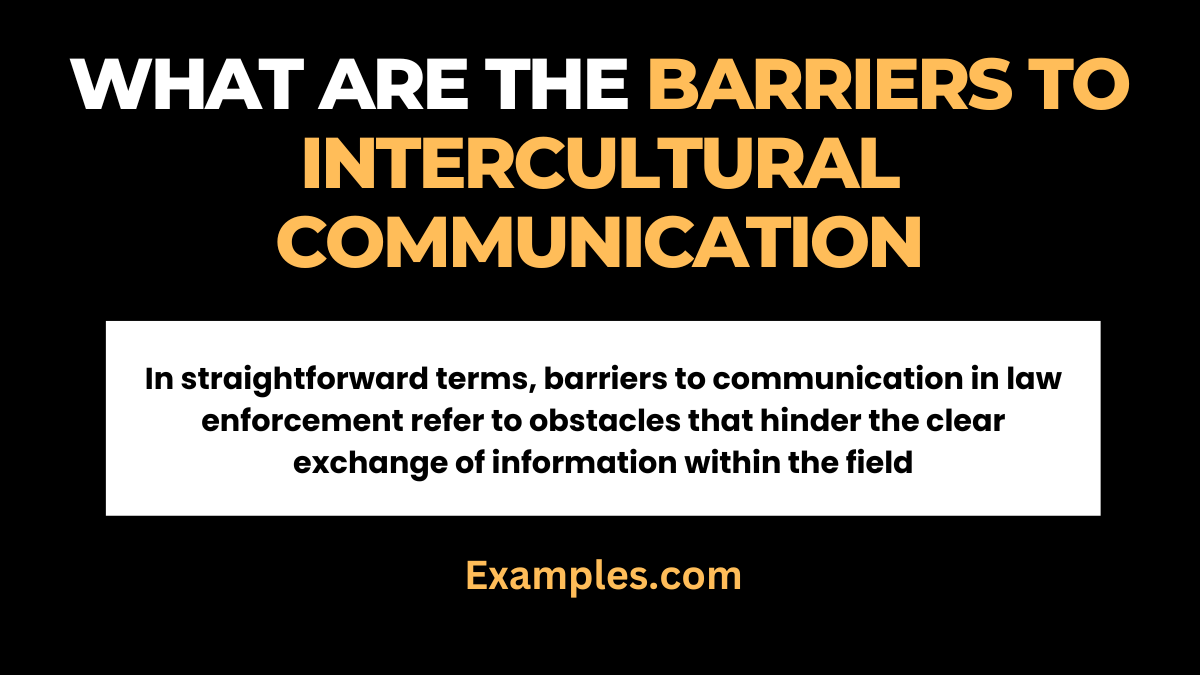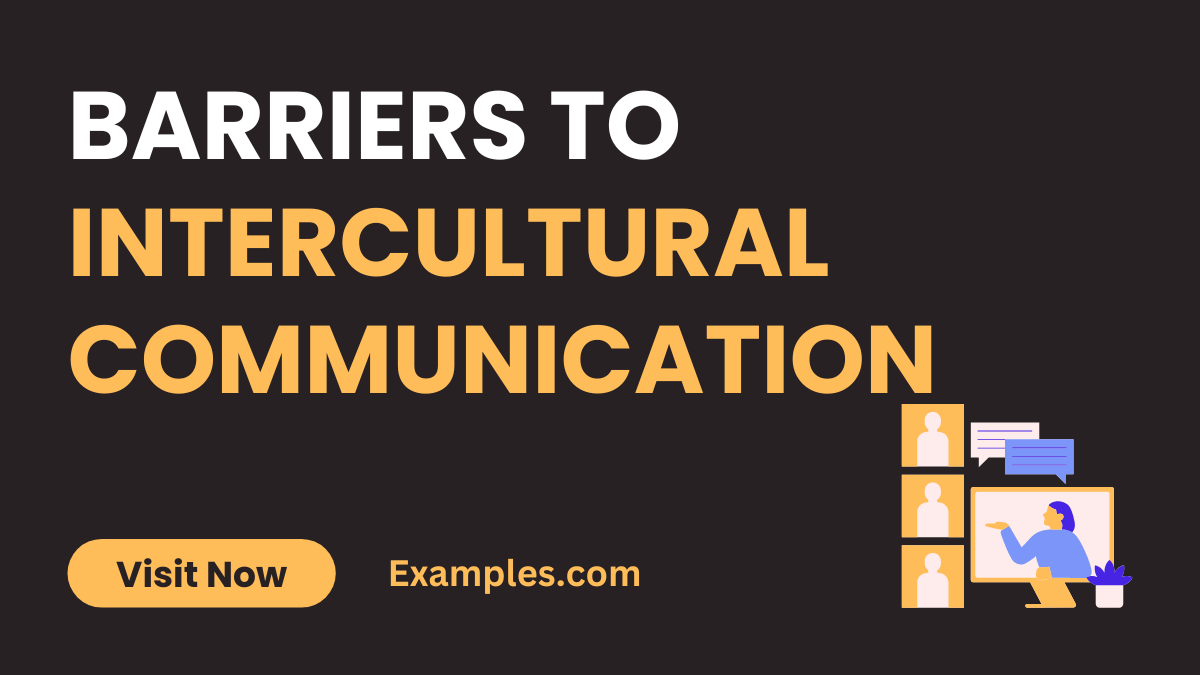14+ Barriers to Intercultural Communication Examples
Embark on a journey to unravel the intricacies of intercultural communication barriers. This comprehensive guide delves into real-world examples, shedding light on challenges faced in diverse settings. Explore strategies, tips, and practical insights to overcome these barriers, fostering effective communication and mutual understanding amidst the rich mosaic of cultures. In this exploration of intercultural dynamics, discover how embracing diversity enhances global connections and enriches interpersonal interactions.
What are the Barriers to Intercultural Communication

Barriers to intercultural communication are obstacles that hinder the smooth exchange of information between individuals from different cultural backgrounds. These hurdles may arise from differences in language, customs, values, or communication styles. Recognizing and understanding these barriers is crucial for fostering effective cross-cultural interactions and building bridges between diverse communities. Overcoming these challenges requires cultural sensitivity, open-mindedness, and a willingness to adapt communication strategies to ensure meaningful connections in multicultural settings.
15 Barriers to Intercultural Communication Examples
Delve into the diverse challenges impeding intercultural communication, from language disparities to cultural nuances. Unravel practical solutions for fostering harmony in cross-cultural exchanges.

- Language Barriers: Overcome language differences through language training programs and employing interpreters for clearer communication.
- Nonverbal Misinterpretations: Address nonverbal cues like gestures to prevent misunderstandings and enhance visual communication.
- Cultural Stereotypes: Challenge stereotypes by promoting cultural awareness, fostering a more nuanced understanding of diverse cultures.
- Ethnocentrism: Mitigate ethnocentrism through cultural humility, valuing diverse perspectives without imposing one’s own.
- Mismatched Communication Styles: Adapt communication styles to match cultural norms, reducing friction and enhancing understanding.
- Prejudice and Bias: Combat prejudice by promoting empathy and emphasizing shared values during intercultural interactions.
- High vs. Low Context Communication: Bridge the gap between high and low context communication by adapting clarity based on cultural context.
- Differing Cultural Norms: Navigate cultural norms by learning and respecting the customs and etiquettes of diverse cultures.
- Ineffective Cross-Cultural Training: Enhance cross-cultural training programs to equip individuals with practical communication skills.
- Cultural Relativism: Avoid cultural relativism pitfalls by recognizing universal values while respecting cultural differences.
- Power Dynamics: Address power imbalances by promoting inclusive dialogue and empowering marginalized voices.
- Communication Apprehension: Overcome communication apprehension through exposure and fostering a supportive environment.
- Technology Gaps: Bridge technology disparities by providing access and training, ensuring equitable communication opportunities.
- Misaligned Priorities: Align priorities through open communication, understanding the significance each culture places on different values.
- Different Approaches to Conflict: Navigate conflict resolution by adapting strategies that respect various cultural approaches to disagreement.
Barriers to Intercultural Communication at Work
Unlock the complexities of intercultural communication within the workplace. Explore practical insights to navigate cultural diversity, fostering a harmonious and collaborative work environment.
- Hierarchical Differences: Establish open communication channels, encouraging employees to share ideas irrespective of hierarchical positions.
- Cultural Hierarchy Perception: Foster a culture of equality by acknowledging and appreciating diverse contributions, breaking down perceived cultural hierarchies.
- Language Proficiency Gaps: Provide language training resources to bridge communication gaps and ensure clear understanding among multilingual teams.
- Communication Styles Clash: Encourage a mix of communication styles, accommodating both direct and indirect approaches for effective workplace collaboration.
- Cultural Celebrations Integration: Incorporate diverse cultural celebrations into workplace activities, fostering inclusivity and strengthening team bonds.
Barriers to Intercultural Communication at University
Explore the challenges of intercultural communication in academic settings. Discover strategies to enhance cultural exchange and create an inclusive educational environment.
- Cross-Cultural Student Engagement: Facilitate cross-cultural interactions through group projects, encouraging students to collaborate and share diverse perspectives.
- International Student Integration: Implement orientation programs to aid international students in adapting to new cultural and academic environments.
- Language Barrier Support: Offer language support services to ensure that language differences do not hinder academic participation and understanding.
- Cultural Awareness Courses: Integrate cultural awareness courses into the curriculum to equip students with the skills to navigate diverse academic settings.
- Faculty Cultural Competency Training: Provide faculty members with training to understand and adapt to diverse cultural expectations and communication styles.
How to Overcome Intercultural Communication Barriers
Navigating the intricacies of intercultural communication requires a nuanced approach. Explore actionable strategies to foster understanding, bridge cultural gaps, and cultivate effective communication in diverse settings.
- Cultural Sensitivity Training: Embrace diversity through training programs that enhance cultural awareness, sensitivity, and the ability to navigate diverse communication styles.
- Language Proficiency Initiatives: Bridge language gaps by implementing language proficiency initiatives, including language courses and translation resources, ensuring clarity in communication.
- Promoting Open Dialogue: Foster open and transparent communication channels, encouraging individuals to express thoughts, concerns, and perspectives without fear of judgment.
- Cross-Cultural Team Building: Cultivate a collaborative environment by promoting team-building activities that encourage understanding, appreciation, and camaraderie among team members.
- Cultural Competency Workshops: Organize workshops focused on developing cultural competency, empowering individuals to adapt to diverse cultural norms and expectations.
- Encouraging Active Listening: Prioritize active listening skills, teaching individuals to attentively understand and respond to verbal and non-verbal cues in diverse cultural contexts.
- Establishing Mentorship Programs: Introduce mentorship programs that pair individuals from different cultural backgrounds, fostering mentor-mentee relationships that facilitate cultural exchange.
- Inclusive Communication Policies: Develop and implement communication policies that prioritize inclusivity, acknowledging and accommodating diverse communication styles within the organization.
- Utilizing Technology Effectively: Leverage technology for seamless communication, ensuring access to communication tools that accommodate diverse technological literacy levels.
- Regular Feedback Mechanisms: Establish regular feedback mechanisms to assess the effectiveness of intercultural communication initiatives, allowing for continuous improvement.
In conclusion, this comprehensive guide illuminates the intricate landscape of intercultural communication barriers. By understanding and addressing these challenges, individuals and organizations can foster a more inclusive and harmonious environment. With real-world examples and actionable insights, this guide serves as a roadmap to navigate the complexities, ensuring effective cross-cultural interactions and creating a global community built on understanding and mutual respect.



